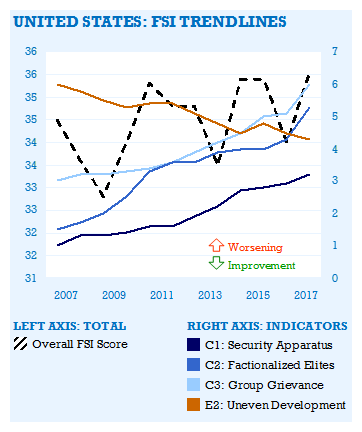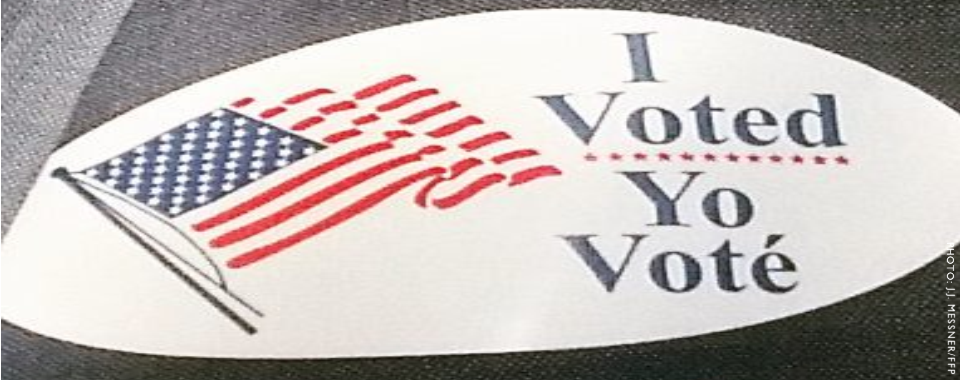BY NATE HAKEN
Society is more resilient to shocks when social, economic, political and security pressures are manageable. However, an improving economy does not guarantee social and political cohesion.
The United States is a case in point. In 2016, unemployment (at 4.9%) was at a 9-year low; GDP per capita (at US$57,500) was at an all-time high; public services, including healthcare, had been improving for the most at-risk populations since 2013. And yet in 2016, two key indicators — Factionalized Elites and Group Grievance — spiked to unprecedented levels during and after a vitriolic presidential election campaign in which polarizing rhetoric was used about Muslims and immigrants, and a series of high-profile police shootings sparked protests across the country, exacerbating racial tensions in African-American communities.
 This is not to say that people are not in economic distress. Certainly, these macro-economic improvements mask long term trends of high inequality which leave large numbers with less margin for error and find themselves slipping through the cracks. Inequality is difficult to measure because depending on how the population is divided up, there are very different results in terms of how much the “winners” are winning and how much the “losers” are losing. For the Uneven Development indicator, the FSI draws heavily on World Bank data such as the GINI Index, which measures variations in income inequality. Income share held by highest and lowest 10%, and difference between rural and urban populations in areas like water and sanitation, which does not show a worsening in inequality over the last 10 years — virtually everybody has running water and toilet facilities. However, as indicated above, there are losers in this economy, including many in mining, manufacturing and retail. And even running water, though virtually universal, is not always as dependable as once taken for granted, as evidenced in Flint, Michigan and many other communities across the country.
This is not to say that people are not in economic distress. Certainly, these macro-economic improvements mask long term trends of high inequality which leave large numbers with less margin for error and find themselves slipping through the cracks. Inequality is difficult to measure because depending on how the population is divided up, there are very different results in terms of how much the “winners” are winning and how much the “losers” are losing. For the Uneven Development indicator, the FSI draws heavily on World Bank data such as the GINI Index, which measures variations in income inequality. Income share held by highest and lowest 10%, and difference between rural and urban populations in areas like water and sanitation, which does not show a worsening in inequality over the last 10 years — virtually everybody has running water and toilet facilities. However, as indicated above, there are losers in this economy, including many in mining, manufacturing and retail. And even running water, though virtually universal, is not always as dependable as once taken for granted, as evidenced in Flint, Michigan and many other communities across the country.
According to a widely-cited article by Anne Case and Angus Deaton,1 the death rate of white Americans between the ages of 45 and 54 increased by over 20% between 1999 and 2013 due in part to drug and alcohol poisoning and suicide.
The economy may be improving, but society is not altogether well. In 2016, people variously diagnosed causes and perpetrators of deep-seated problems and chased after radical solutions. But it was not inevitable that Group Grievance and Factionalized Elites would suddenly spike as much as they did at this point in time. There was no major crisis (disaster, pandemic, recession, or attack) that triggered it. For forecasters, this should give pause … unless the unit of analysis is not necessarily the state and something bigger is blowing in the wind.
The year 2016 was also a year of resurgent nationalism in other Western countries, such as in Austria, France, and the Netherlands. It was also the year of Brexit. When the British voted 51.9% to 48.1% to leave the European Union, it was perhaps the most significant geo-political development of the year. The “Leave” campaign made the argument that over-regulation was holding back the economy and that immigrants were taking British jobs. It is true that after the global financial crisis, economic vitality in the U.K. has not been the same: GDP Per Capita peaked in 2007 at $49,949 and by 2009 had plummeted to $38,010 and been limping along ever since. Granting that the British economy has been less than robust for the last 15 years, why would cracks form in the European Union now? The U.K. has been a member of the European Union since 1973, so these are surely not new issues.

In retrospect one might connect the dots in any number of different ways. For instance, rising social and political tensions across the West could be attributed to rising fears of economic dislocation in the context of globalization, exacerbated by social and cultural fears triggered by the effects of Arab Spring (conflict, terrorism, and mass displacement). Perhaps these fears were amplified and distorted by a furious storm of social media in a new communication landscape. If this is the case, it would suggest that volatility is not going away anytime soon. For policy makers seeking to promote resilience in such a complex environment, tariffs, walls, and bans will only go so far.
Endnotes
1. http://www.pnas.org/content/112/49/15078.full
